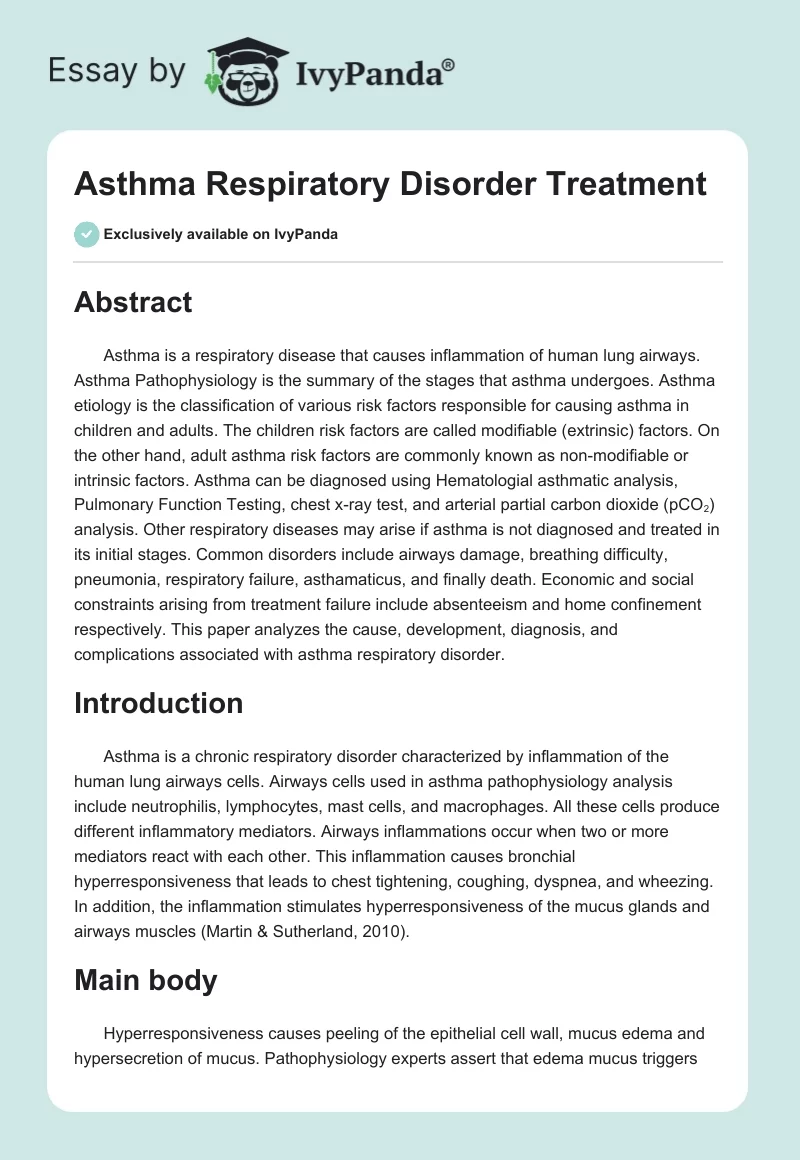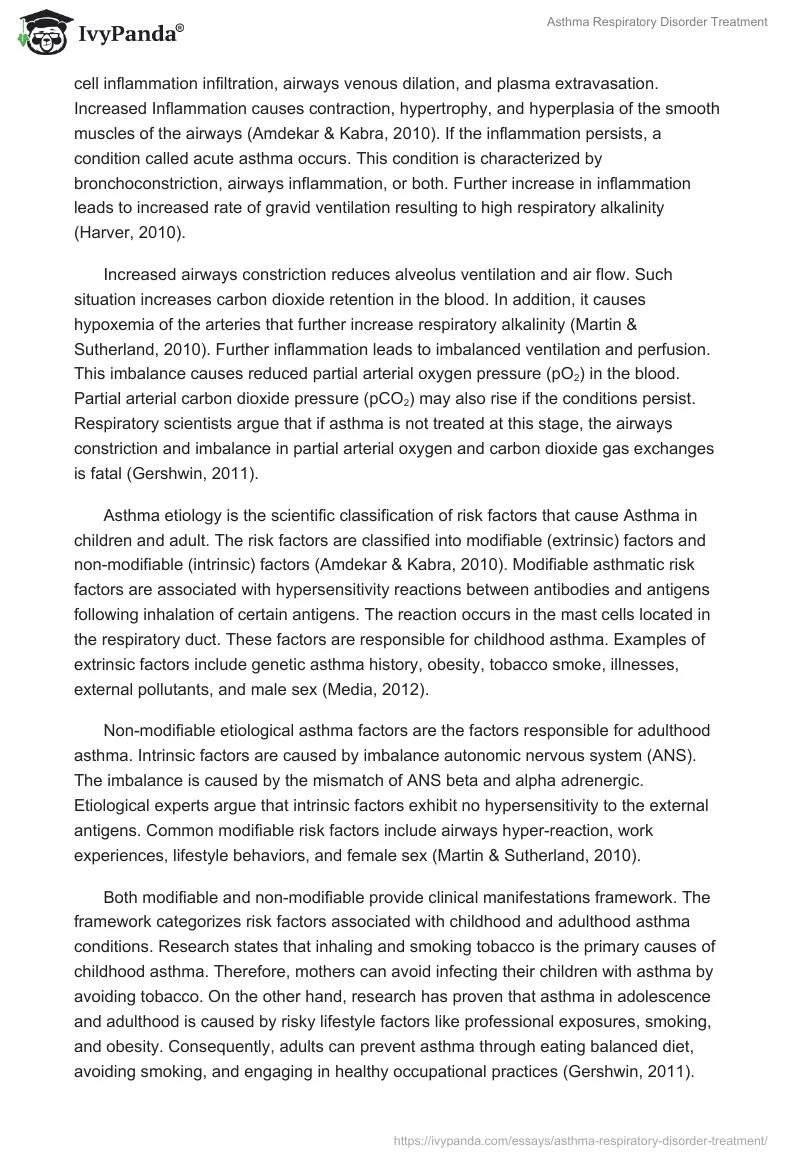Abstract
Asthma is a respiratory disease that causes inflammation of human lung airways. Asthma Pathophysiology is the summary of the stages that asthma undergoes. Asthma etiology is the classification of various risk factors responsible for causing asthma in children and adults. The children risk factors are called modifiable (extrinsic) factors. On the other hand, adult asthma risk factors are commonly known as non-modifiable or intrinsic factors. Asthma can be diagnosed using Hematologial asthmatic analysis, Pulmonary Function Testing, chest x-ray test, and arterial partial carbon dioxide (pCO2) analysis. Other respiratory diseases may arise if asthma is not diagnosed and treated in its initial stages. Common disorders include airways damage, breathing difficulty, pneumonia, respiratory failure, asthamaticus, and finally death. Economic and social constraints arising from treatment failure include absenteeism and home confinement respectively. This paper analyzes the cause, development, diagnosis, and complications associated with asthma respiratory disorder.
Introduction
Asthma is a chronic respiratory disorder characterized by inflammation of the human lung airways cells. Airways cells used in asthma pathophysiology analysis include neutrophilis, lymphocytes, mast cells, and macrophages. All these cells produce different inflammatory mediators. Airways inflammations occur when two or more mediators react with each other. This inflammation causes bronchial hyperresponsiveness that leads to chest tightening, coughing, dyspnea, and wheezing. In addition, the inflammation stimulates hyperresponsiveness of the mucus glands and airways muscles (Martin & Sutherland, 2010).
Main body
Hyperresponsiveness causes peeling of the epithelial cell wall, mucus edema and hypersecretion of mucus. Pathophysiology experts assert that edema mucus triggers cell inflammation infiltration, airways venous dilation, and plasma extravasation. Increased Inflammation causes contraction, hypertrophy, and hyperplasia of the smooth muscles of the airways (Amdekar & Kabra, 2010). If the inflammation persists, a condition called acute asthma occurs. This condition is characterized by bronchoconstriction, airways inflammation, or both. Further increase in inflammation leads to increased rate of gravid ventilation resulting to high respiratory alkalinity (Harver, 2010).
Increased airways constriction reduces alveolus ventilation and air flow. Such situation increases carbon dioxide retention in the blood. In addition, it causes hypoxemia of the arteries that further increase respiratory alkalinity (Martin & Sutherland, 2010). Further inflammation leads to imbalanced ventilation and perfusion. This imbalance causes reduced partial arterial oxygen pressure (pO2) in the blood. Partial arterial carbon dioxide pressure (pCO2) may also rise if the conditions persist. Respiratory scientists argue that if asthma is not treated at this stage, the airways constriction and imbalance in partial arterial oxygen and carbon dioxide gas exchanges is fatal (Gershwin, 2011).
Asthma etiology is the scientific classification of risk factors that cause Asthma in children and adult. The risk factors are classified into modifiable (extrinsic) factors and non-modifiable (intrinsic) factors (Amdekar & Kabra, 2010). Modifiable asthmatic risk factors are associated with hypersensitivity reactions between antibodies and antigens following inhalation of certain antigens. The reaction occurs in the mast cells located in the respiratory duct. These factors are responsible for childhood asthma. Examples of extrinsic factors include genetic asthma history, obesity, tobacco smoke, illnesses, external pollutants, and male sex (Media, 2012).
Non-modifiable etiological asthma factors are the factors responsible for adulthood asthma. Intrinsic factors are caused by imbalance autonomic nervous system (ANS). The imbalance is caused by the mismatch of ANS beta and alpha adrenergic. Etiological experts argue that intrinsic factors exhibit no hypersensitivity to the external antigens. Common modifiable risk factors include airways hyper-reaction, work experiences, lifestyle behaviors, and female sex (Martin & Sutherland, 2010).
Both modifiable and non-modifiable provide clinical manifestations framework. The framework categorizes risk factors associated with childhood and adulthood asthma conditions. Research states that inhaling and smoking tobacco is the primary causes of childhood asthma. Therefore, mothers can avoid infecting their children with asthma by avoiding tobacco. On the other hand, research has proven that asthma in adolescence and adulthood is caused by risky lifestyle factors like professional exposures, smoking, and obesity. Consequently, adults can prevent asthma through eating balanced diet, avoiding smoking, and engaging in healthy occupational practices (Gershwin, 2011).
Asthma infection can easily be diagnosed in most health centers through the following methods. In Sputum analysis method, asthmatic patient’s sputum is characterized by purulent appearance, contents of Cursch-mann mucous and presence of eosiophilis debris. Hematologial asthmatic analysis may establish the presence of eosiophilis content for both modifiable and non-modifiable asthma conditions (Martin & Sutherland, 2010).
Pulmonary Function Testing analyses the status of the Forced Vital Capacity (FVC). Asthmatic patients exhibit a reduction in lung conformity, residual lung volume, and the total lung capacity. Asthma is also diagnosed using chest x-ray test analysis. Asthmatic patient exhibits inflated airways in their lungs. The final asthma test is the carbon dioxide blood test. Asthmatic victims have (pCO2) content of more than 40 mm Hg. High content of (pCO2) is attributed to constriction of airways due to inflammation of the epithelial walls and muscles (Gershwin, 2011).
Conclusion
Failure to diagnose and treat asthma in early stages results to adverse health complications. It is worth noting that asthma complication in children and adult are similar. The most common complications include permanent airways damage, breathing difficulties, absenteeism in schools or work and home confinement. In few cases, asthma results to advanced respiratory conditions like pneumonia, lung and respiratory failure, wheezing, asthmaticus and finally death (Harver, 2010).
References
Amdekar, Y. K., & Kabra, S. K. (2010). Allergy and asthma. New Delhi: Elsevier.
Gershwin, M. E. (2011). Bronchial asthma a guide for practical understanding and treatment (6th ed.). New York: Springer.
Harver, H. K. (2010). Asthma, Health and Society. New York: Springer US.
Martin, R. J., & Sutherland, E. R. (2010). Asthma and infections. New York: Informa Healthcare.
Media, A. (2012). Asthma a troubleshooting guide to common childhood ailments.. Cincinnati: F+W Media.


